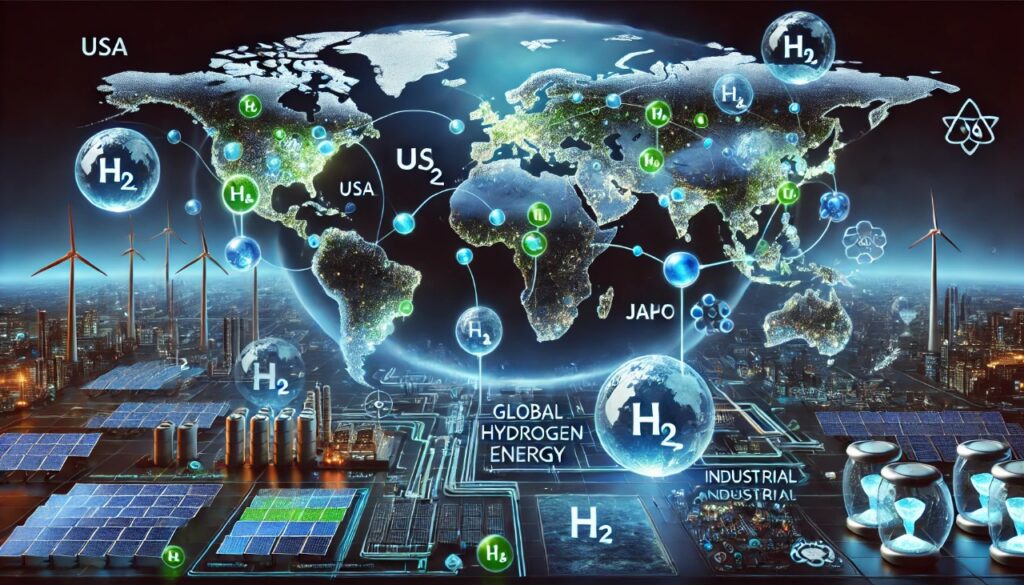Dear Clean Energy Bees!
Global Hydrogen Strategies: The Green Energy Race Between Nations
The global energy landscape is profoundly transforming as nations increasingly turn to hydrogen to decarbonize their economies. Hydrogen, especially green hydrogen, has emerged as a central player in the energy mix, offering a clean fuel for sectors that are difficult to electrify, such as heavy industry, transportation, and long-duration energy storage. As countries race to meet ambitious net-zero targets, green hydrogen has become more than just a fuel—it is a geopolitical asset, an economic opportunity, and a central pillar of international relations in the realm of energy international affairs.
In this global hydrogen economy race, G20 nations are at the forefront, each developing unique national strategies to secure their place in the future hydrogen economy. Bilateral relations and international collaboration are integral to the development of hydrogen infrastructure, with industry leaders and governments recognizing the potential for global partnerships to accelerate hydrogen production, storage, and export.
Hydrogen and Its Global Appeal in Clean Energy Transition
Hydrogen offers great potential as a clean energy carrier. In the form of green hydrogen, produced through water electrolysis powered by renewable energy sources, hydrogen can decarbonize industries like steel, cement, and heavy-duty transportation, which are difficult to electrify. Its versatility as both a fuel and an energy storage medium makes it a critical part of the transition to clean energy systems worldwide.
Countries are not just competing to develop hydrogen technologies domestically; they are also seeking bilateral collaborations to secure a foothold in the growing global hydrogen economy. By leveraging each other’s strengths—whether it’s abundant renewable energy resources or advanced fuel cell technologies—nations are building the foundations for a future hydrogen economy that will shape global energy international affairs.
Bilateral International Relations in Hydrogen
As the hydrogen market grows, countries are forming strategic partnerships to share resources, expertise, and technologies. These international collaborations often focus on hydrogen production, technology transfer, infrastructure development, and export markets. These bilateral relations can take various forms, from government-to-government agreements to private-sector partnerships. A few noteworthy examples include:
1. Australia and Japan: Hydrogen Export Hub
Australia, with its vast solar and wind resources, is positioning itself as a global exporter of green hydrogen. Japan, a country that lacks significant natural resources but is a technological leader in fuel cells, is a key partner in Australia’s hydrogen ambitions. In 2020, Japan and Australia signed a landmark agreement to develop the “Hydrogen Energy Supply Chain” project. This agreement aims to produce and export green hydrogen from Australia to Japan, marking one of the first large-scale hydrogen export projects. Industry leaders like Japan’s Toyota and Australia’s Fortescue Metals Group are heavily involved in pushing these efforts forward, as both countries are eager to harness hydrogen to reduce emissions in industries like transportation and power generation.
2. Germany and the Netherlands: Building a Hydrogen Backbone
Germany is one of the world’s leaders in hydrogen development, and its collaboration with the Netherlands is central to its strategy. The two countries are working together on the “Hydrogen Backbone” project, which aims to create a pan-European hydrogen transport network. This initiative will connect multiple countries, including Belgium, France, and Denmark, facilitating the flow of hydrogen across borders. Both countries are investing heavily in hydrogen infrastructure, with Germany’s investment plan totaling €9 billion and the Netherlands aiming to become a key player in Europe’s hydrogen trade. Leading companies in both countries, including Siemens and Shell, are driving these efforts to create a robust cross-border hydrogen infrastructure.
3. Saudi Arabia and South Korea: Joint Hydrogen Initiatives
Saudi Arabia, traditionally known for its oil exports, is positioning itself as a future leader in the hydrogen economy. The Kingdom has established a strong partnership with South Korea, one of the world’s leaders in hydrogen technology, particularly in the fuel cell sector. In 2020, the two nations signed a memorandum of understanding (MoU) to cooperate on hydrogen production and technology development. The collaboration focuses on developing green hydrogen, leveraging Saudi Arabia’s vast solar energy potential and South Korea’s advanced fuel cell technologies. Industry leaders like Saudi Aramco and Hyundai are involved in these initiatives, pushing for large-scale hydrogen production and infrastructure development.
4. Canada and the European Union: Hydrogen Cooperation
Canada is building a strong hydrogen partnership with the European Union, focusing on both green and blue hydrogen. The Canadian government is working to develop hydrogen technologies that will be exported to Europe, where hydrogen is expected to play a crucial role in the energy transition. In 2020, Canada and the EU signed a joint declaration on hydrogen cooperation, signaling a new era of collaboration between the two. Canadian companies like Hydrogenics (now part of Cummins) and Ballard Power Systems are working alongside EU stakeholders such as Siemens and BASF to develop hydrogen solutions for industries like transportation, steel production, and power generation.
These bilateral partnerships are critical to the global hydrogen economy, as they not only enable the exchange of resources and technology but also create a foundation for a global hydrogen market. Through these collaborations, countries are positioning themselves as key players in a competitive and rapidly growing industry.
The Future of Hydrogen: Global Collaboration and Innovation
The future of hydrogen is closely tied to international collaboration. As nations and industry leaders continue to develop hydrogen technologies, create infrastructure, and build global markets, the role of bilateral relations and multilateral agreements will only increase. International partnerships will drive innovation, lower costs, and create economies of scale, enabling hydrogen to become a major player in the global energy landscape.
Countries like Australia, Japan, Germany, Saudi Arabia, and Canada, alongside industry leaders such as Siemens, Shell, Toyota, and Fortescue, are not just competing for market share—they are building the foundation for a global hydrogen economy. This race is not just about energy security and decarbonization but about creating new economic opportunities, establishing technological leadership, and enhancing geopolitical influence. The nations and companies that succeed in this race will shape the future of energy, industry, and international trade for decades to come.
Conclusion
The global hydrogen economy is rapidly evolving, with G20 nations and major industry players pushing forward with aggressive hydrogen strategies. These strategies involve not only domestic innovation and infrastructure development but also bilateral and multilateral cooperation to create a seamless global hydrogen market. As countries and companies forge partnerships and invest heavily in hydrogen technologies, the stage is being set for a cleaner, more sustainable energy future. By collaborating and sharing expertise across borders, nations, and industries are ensuring that hydrogen will play a central role in the transition to a low-carbon world.
Agastya Hydrogen is all set to fulfill the G20 nation’s green hydrogen visions and Mission with our net zero-achieving innovations with the highest green hydrogen-producing products; Agastya AEM electrolyser and Agastya HRS. An open warm invite to every green hydrogen enthusiast to visit Agastya Hydrogen stall at India Energy Week happening on 11-14th Feb at Yashobhoomi, New Delhi.
We always want to hear more from our valuable readers on the DNA Of Agastya Hydrogen, do share your thoughts on sustainable energies at hello@agastyah2.com.



